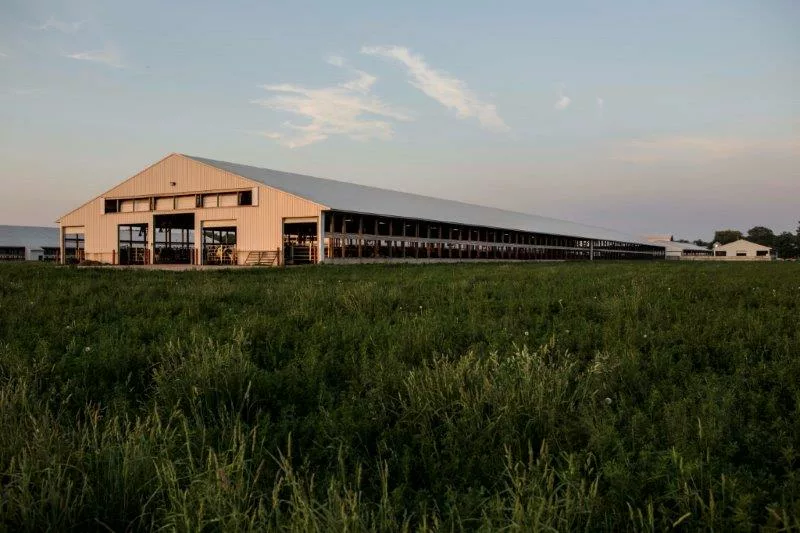When you hear the word “farm” your mind may take you to a large red barn, lush green fields and animals scattered about grazing. That’s the iconic image often played out in books, on screen, on merchandise from coffee mugs to toys (as a kid I loved my Fisher Price farm), and on food packaging to harken back to simpler times.
In reality, farms look very different today. There are fewer and they are bigger. There are more employees, more equipment, more acres and large buildings where animals are housed that don’t look at all like those red barns we remember.
Many farms are incorporated – in other words, corporate farms, 98 percent of which are family-owned, and a majority have been handed down through generations. Traditionally, farms have had very low profit margins. So to meet the growing demand for food, while maintaining an income, supporting their families and passing on the farm to their kids, farmers have had to grow their businesses.
The agriculture industry as a whole has evolved like every other industry – consolidating, integrating, advancing. It’s how farmers produce food more efficiently and safely for all of us. But “big” doesn’t mean “bad,” as some would like us to believe.
The Double F- Bomb
We often hear the label “Factory Farm” – or as I call it, the “double F-bomb.” (No, I’m not swearing. But I likely made you do a double take.) The label has different meaning to different people, often causing confusion and sometimes evoking anger. Most often it carries a very negative connotation that doesn’t reflect what’s happening in animal agriculture today.
Change is hard, but all industries change. That’s a good thing! Think about phones. Over the decades, we’ve gone from large, plastic rotary dial phones attached to a wall with a cord to super-slim, hand-sized gadgets that not only make calls but connect us to the world in a variety of ways. It’s that same forward-thinking, innovation and spirit of continuous improvement that has resulted in the amazing farms we have today.
Particularly in animal agriculture, farms leverage the latest technology to house animals in climate-controlled buildings, and closely monitor their feed and water. Biosecurity measures are implemented to ensure disease stays out of the facility.
Larger farms allow for specialization. Farmers and other trained caretakers tend daily to the animals. For example, a larger pig farm might have one or two employees who care for baby pigs only. This allows those caretakers to become really good at recognizing and managing health issues early. Diets are specially formulated for the stage of life and growth by nutritionists. Routine veterinary care ensures animal health and wellbeing. It takes a team of experts.
Environmental sustainability is important, too. For example, in these high-tech buildings, farmers can capture manure that is then used to fertilize crops, that in turn feed the animals. Soil testing and precision agriculture technology allow for manure, other nutrients, crop protection products and even water to be applied only where needed to ensure healthy plants and prevent overuse and waste. It’s an elegant cycle!
On some farms, manure is sent to methane digesters to produce electricity for communities and natural gas (as a bonus, odor is reduced, too). Farmers are the original stewards of the land – and continue to make strides to protect the planet’s natural resources and reduce agriculture’s carbon footprint.
Animal agriculture certification programs like the pork industry’s We Care initiative and the National Dairy Farm program provide assurances that farmers are doing the right things for the right reasons.
Phibro is proud to work with dairy farms through Our Dairy Values™ – an initiative where we work with farm leadership to help farmers identify their farm purpose and core values – to strengthen their culture and communicate to the public how they live out values and purpose every day.
Let’s Drop It
All of these efforts have resulted in the U.S. having the safest and most affordable food supply on the planet – from farmers who are able to produce more with less.
While farming has changed dramatically, today’s farmers still have the same values of their parents, grandparents and great grandparents who farmed before them. It doesn’t matter if they’re raising 100 or 10,000 animals, planting 100 or 10,000 acres, or using organic or conventional methods.
To continue to meet the growing global demand for food, produce the variety today’s consumers crave and protect the environment, agricultural professionals must continue to innovate – and I have no doubt they will. It’s something they’ve been doing for centuries.
So can we drop the double F-bomb? Modern farms aren’t factories. They are places where families work hard with their team of experts to produce our food – caring for their animals, their employees and our precious natural resources.
As consumers, we deserve food produced responsibly. And as someone who grew up with a love for the farm, cares for livestock and works with farmers nearly every day – I can assure you that is what we are getting.
